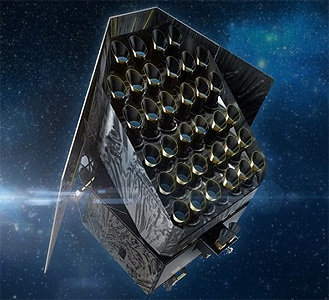Thank you very much for visiting Gunter's Space Page. I hope that this site is useful and informative for you.
If you appreciate the information provided on this site, please consider supporting my work by making a simple and secure donation via PayPal. Please help to run the website and keep everything free of charge. Thank you very much.
PLATO

PLATO [OHB]
PLATO (Planetary Transits and Oscillations of stars) is the third medium-class mission in ESA's Cosmic Vision programme. Its objective is to find and study a large number of extrasolar planetary systems, with emphasis on the properties of terrestrial planets in the habitable zone around solar-like stars. PLATO has also been designed to investigate seismic activity in stars, enabling the precise characterization of the planet host star, including its age.
PLATO will observe a large sample of bright stars. In this way PLATO is able to completely characterize the discovered planets and their hosting stars. Specifically, the characterization includes the seismic analysis of the parent stars in order to precisely determine their mass, radius and age, i.e. those fundamental parameters that are required to precisely derive the same quantities for the hosted planets.
The key scientific goals are:
- Detection of terrestrial exoplanets in the habitable zone of solar-type stars and characterization of their bulk properties needed to determine their habitability.
- Characterization of thousands of rocky (including Earth twins), icy or giant planets, including the architecture of their planetary system, to fundamentally enhance our understanding of the formation and the evolution of planetary systems.
These goals will be achieved through:
- planet detection and radius determination (2% precision) from photometric transits;
- determination of planet masses (better than 10% precision) from ground-based radial velocity follow-up,
- determination of accurate stellar masses, radii, and ages(10% precision) from asteroseismology,
- identification of bright targets for atmospheric spectroscopy.
The payload consists of a set of 32 normal cameras organized in four groups resulting in many wide-field co-aligned telescopes, each telescope with its own CCD-based focal plane array and an aspherical telescope with 6 lenses per telescope. Additionally there is a set of two fast cameras for bright stars, colour requirements, and fine guidance and navigation.
In February 2014, the SPC selected PLATO as the M3 mission of the Cosmic Vision 2015-2025 programme. OHB System was selected in June 2018 to build the spacecraft and the instruments.
| Nation: | Europe |
|---|---|
| Type / Application: | Astronomy |
| Operator: | ESA |
| Contractors: | OHB-System GmbH |
| Equipment: | 32 aspherical telescopes |
| Configuration: | |
| Propulsion: | |
| Power: | Solar cells, batteries |
| Lifetime: | > 6 years |
| Mass: | |
| Orbit: | L-2 halo orbit |
| Satellite | COSPAR | Date | LS | Launch Vehicle | Remarks | |
|---|---|---|---|---|---|---|
| PLATO | - | 2026 | Ko ELS | Ariane-62 (baselined) |
References:
- ESA: PLATO
- PLATO website
Large class: Medium class: Small class: Fast class:
